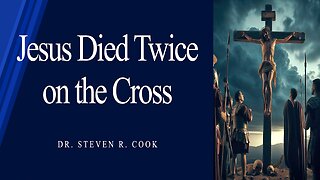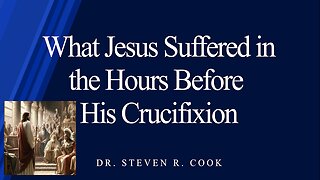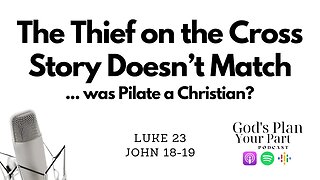The Cross & Crucifixion of Jesus
The word “cross” translates the Greek noun stauros (σταυρός), which refers to “a pole to be placed in the ground and used for capital punishment, cross.” (BDAG, 941). The word “crucify” translates the Greek verb stauroō (σταυρόω), which means, “to fasten to a cross, crucify.” (BDAG, 941). Crucifixion was practiced by ancient cultures such as the Egyptians (Gen 40:19), Persians (Est 7:10), Assyrians and Greeks. By the time of Christ, the Romans had used crucifixion as a means of death more than previous cultures.
Just prior to crucifixion, a person was scourged with a whip which had thongs that were braided with sharp objects such as nails. As an act of public humiliation, criminals carried their own cross to the place of execution, and once there, were stripped naked before being fastened to the cross, either with rope or nails. Being tied to a cross with ropes was less painful in the beginning, but would leave the victim to hang for a longer period of time, even days, which would make the experience more painful in the end. Some who were tied to the cross are recorded to have lasted for nine days. Nailing a person to a cross was more painful from the beginning and would have led to a quicker death. The body would hang between three to four feet from the ground. Sometimes a soporific was given to the victim to help numb the senses. In Jesus case, it was “wine mixed with myrrh” (Mark 15:23), which our Lord rejected because it would have clouded His thinking (Matt 27:34). In some situations the Romans would break the victim’s legs which would hasten death, but according to Scripture, Jesus was already dead by the time the soldiers considered doing this (John 19:32-34). We know that Joseph of Arimathea, a disciple of Jesus, came to Pilate and asked for Jesus’ body, that he might bury it, and Pilate granted his request (Matt 27:57-60).
The cross of Christ became central to the message of the gospel. The apostle Paul was sent by the Lord Jesus “to preach the gospel, not in cleverness of speech, so that the cross of Christ would not be made void” (1 Cor 1:17). Paul was not concerned with human sophistry, winning arguments, or impressing his audience by means of rhetorical prowess, but merely with presenting the simple message of the cross of Christ, which brings eternal salvation to those who trust in Jesus as their Savior. Paul continued his line of reasoning, saying, “For the word of the cross is foolishness to those who are perishing, but to us who are being saved it is the power of God...[and] we preach Christ crucified, to Jews a stumbling block and to Gentiles foolishness, but to those who are the called, both Jews and Greeks, Christ the power of God and the wisdom of God” (1 Cor 1:18; 23-24). Paul summarized his message when he said, “I determined to know nothing among you except Jesus Christ, and Him crucified” (1 Cor 2:2). The image of a crucified Savior seems entirely foolish to a world that creates its saviors out of strong heroes; strong in the human sense of one who can save himself and others. Jesus is certainly strong; after all, He’s God! And He does save forever those who come to Him in faith. However, the humility of the cross, with all its offense and shame, leaves no place for human wisdom or pride; for one must admit it was his sin that placed Messiah on the cross to be judged and die. To come to Jesus as a crucified Messiah requires humility, for one must honestly look at oneself from the divine perspective and admit he is a lost sinner in need of a Savior. A Savior who was willing to lay down His life and bear the punishment of the guilty. This requires truth, to see oneself from the divine perspective as utterly sinful and lost. And it requires humility, to admit one it powerless and cannot save himself from a damnable future to which he is certainly headed. It is the work of Messiah that saves. Nothing more is required. Jesus paid it all.
-
 20:04
20:04
adelphoi45
2 months agowhat did the cross Jesus get hung on look like?
1881 -
 22:20
22:20
Thinking on Scripture
6 months agoJesus Died Twice on the Cross
156 -
 33:20
33:20
Thinking on Scripture
6 months agoWhat Jesus Suffered in the Hours Before His Crucifixion
74 -
 24:02
24:02
Gods Plan Your Part
4 months agoMatthew 27 | The Crucifixion Story: Judas, Pilate, and Resurrected Saints?
31 -
 5:39
5:39
Christian Testimonials, Bible Scriptures and Commentary
2 months agoJesus Sacrificial Death on the Cross Burial and Resurrection- Salvation
558 -
 16:03
16:03
Gods Plan Your Part
5 months agoLuke 23, John 18-19 | A Closer Look at Pilate, The Thief on the Cross and Bible Contradictions
28 -
 21:50
21:50
Gods Plan Your Part
4 months agoMatthew 16 | Remember What God Has Done For You And Carry the Cross
221 -
 2:04
2:04
Independent Fundamental Baptist Hymns
6 months agoBeneath the Cross of Jesus (FWBC)
32 -
 7:08
7:08
Jesus Answers Prayer
2 months ago $0.01 earned✝️ Isaiah 53: The Divine Sacrifice & Exaltation of Jesus Christ 🔥 🙏
39 -
 24:13
24:13
Gods Plan Your Part
2 months agoLuke 23 | Unveiling the Crucifixion: Simon of Cyrene, Pilate's Dilemma, and Prophecy Fulfilled
12